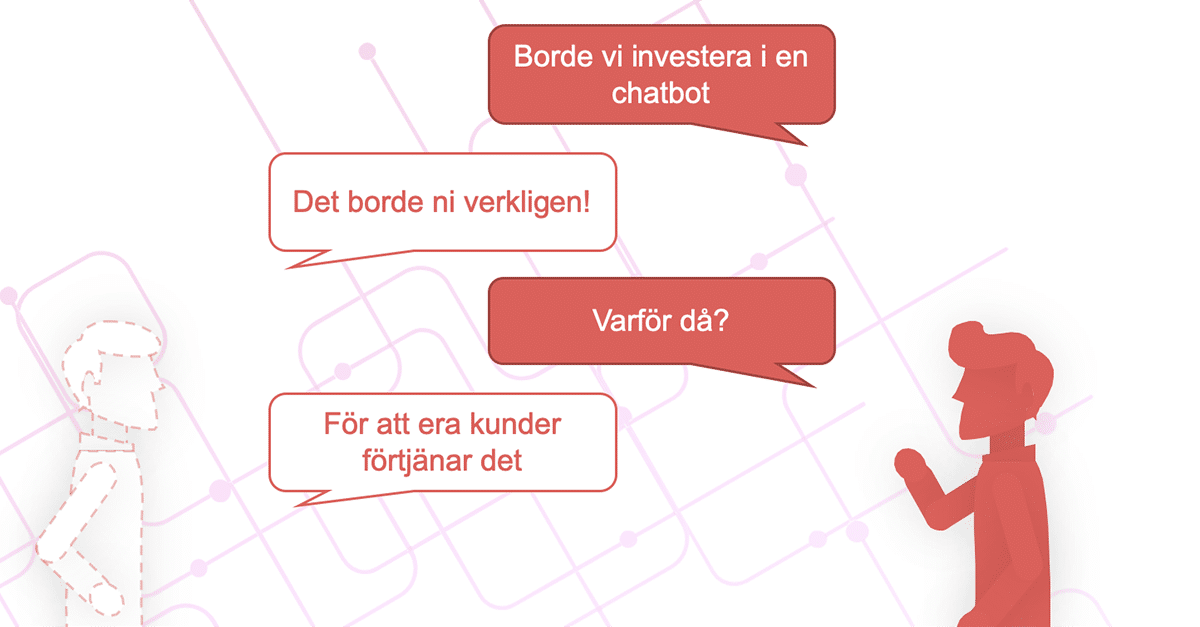Chatbots, or Conversational AI, if you want to be nitpicky, is a phenomenon that is constantly growing. Gartner estimates that the global market for chatbots will pass USD 9 billion in annual sales by 2024, and within the next two years, 70% of all salaried employees will already be using chatbots on a daily basis. We are sure that you can find reasons to wait before taking the plunge, but in this blog post Pelle Stridh, an AI evangelist at Softronic, gives you seven reasons why you should NOT wait.

Better service for customers
Conversational AI enables you to offer your customers yet another channel of communication. More and more people prefer to use chats than talk on the phone, and I personally think that sending questions by email should soon be just as rare as writing physical letters. Many people also find it easier to express themselves in writing than in speaking, and in a chat they can tell you what they want help with more quickly and easily.
As each day goes by, more and more users (citizens) expect to get help immediately, and this is where chats are both more effective and more easily accessible as a channel.
Better quality answers
A conversational AI will always give the same answers, more or less, to similar questions. As the whole concept is based on working out what the user is writing using AI (NLP and NLU), there is very little scope for interpretation, and if the chatbot is in any doubt, it will instead guide the user on the right path by asking follow-up questions – a conversational AI in other words. You will not receive a different answer depending on the day of the week, the time of day or the mood of the employee.
Saves time
If you have a conversational AI, you actually save time for both the user and the employees who would otherwise have to answer all the questions by phone or email. The user saves time by not having to look for the information themselves on a website or by not having to wait in a queue on the phone. People are also inherently a bit ‘lazy’.
Employees working for customer service or an internal help desk will also save time, as the most frequently asked and repetitive questions will be answered by a conversational AI instead. Over time, this amount of knowledge (the questions and areas that can be understood and answered by a conversational AI) will increase based on real outcomes.
Greater accessibility
A conversational AI works 24/7, which is something that the users will quickly appreciate. However, my experience is that it can take time for behaviour to change. This is because users are historically used to certain kinds of operations not offering help outside office hours or at weekends, such as municipal or government operations. Having said that, we’ve already seen that more than 40% of all conversations are already taking place outside offices hours after a few months in all the implementations we have made; including, for example, the chatbot Skatti at the Swedish Tax Agency.
A more personal service
A conversational AI not only offers better service and higher quality, but also a more personal service. If we compare the information that appears on a website, it is normally written in a general way and a textual answer can include three to four different scenarios; but only one of these scenarios relates to your specific situation. It can be difficult for many people to interpret these answers and feel confident that they have found the answer to ‘MY’ question.
If a conversational AI has been built well, the user will feel that they are receiving personal answers and that the conversation is targeted at them personally. Once again, there should be no room for interpretation.
In measurements we have performed, we have seen that 92% of users think they were treated in a friendly way by the chatbots we have implemented and as high as 83% said that they received comprehensive answers to their question.
Cheap way of creating quick and effective value
If you choose the right platform when building your Conversational AI, this kind of project does not have to cost a fortune. If you have two experienced AI trainers and 2-3 of your own resources who know all about the operations that the chatbot needs to be trained in, you can go live in as early as 12 weeks. In this period of time we will have built a Conversational AI that can master around 300-400 different ‘intents’, i.e. the number of different questions that it should be able to answer. If you have prioritised the right intents when training the chatbot, you can already reduce all the incoming questions from other channels, including by phone and email, by 30%.
Ripple effect
If you also make sure that the knowledge for this Conversational AI is built in the ‘right way’, i.e. that its ability to detect intents in written text is extremely accurate, this will also give you a solid foundation for your continued investment in adjacent AI areas, such as voice to text in voice conversations or intent detection in written text in emails …. or to support customer service…. or the internal help desk… or… Yes, you get the picture.
So let’s round off here
As I said, value can be measured in many different ways. I wanted to use these 7 arguments to show you the total value that you can achieve by choosing to ‘hire’ a Conversational AI right now, and give your users the help and support they deserve – quite simply a great and friendly experience!
Blog post written by Pelle Stridh for Softronic AB
